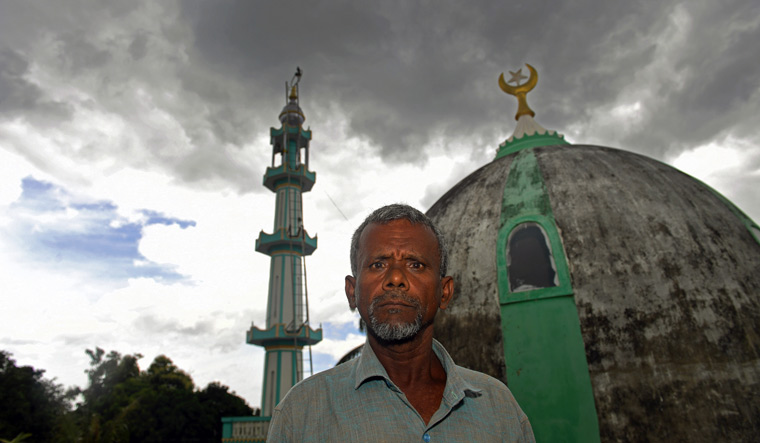At the foothills of the Western Ghats, on the southwestern border of Tamil Nadu, lies Meenakshipuram, a village just off the town of Panpozhi in Thenkasi district. It is a two-hour drive from Tirunelveli over bumpy roads. As you enter the village, a crescent atop the dome of the mosque glints in the morning light. The lane opposite the mosque is dotted with houses of Hindus and Muslims. An eerie silence belies the tumultuous upheaval that took place here, four decades ago.
Rahamathullah, 53, who works as a muthavalli (accountant), walks into the mosque and greets Fairoz Khan, 48, who is arranging firewood. Fairoz is employed in the mosque to recite the prayers every day. “We have overcome those difficult times. We are happy following Islam now,” said Rahamathullah.
He was 13 when Meenakshipuram, now called Rahmath Nagar, witnessed violent caste clashes. Rahmathullah was then known as Ganesan, a dalit. He was studying in a school at Panpozhi. But as Ganesan and his family faced discrimination, his family converted to Islam. His father’s brother Murugaiyan, though, still follows Hinduism. “They did not convert. But we do not have any differences. We still get together for family functions,” said Rahmathullah. Fairoz was eight when his family converted. “I remember that our village was plunged into huge turmoil. But I don’t know why my parents converted,” he said.
In 1981, Meenakshipuram stunned the nation when over 300 dalit families in the village converted to Islam on a single day. The families came together the next day to build a mosque, which stands testimony to the humiliation and the agony the dalits underwent then. The dalits here are from the Pallar community, while the upper castes are the Thevars. Though they hold the same economic status, the Thevars do not accept Pallars as their equals. So, the dalit families converted to Islam.
In a state that came of age with Periyar’s anti-caste movement, the mass conversions in Meenakshipuram irked the Hindu right wing across the country. Hindu leaders like Atal Bihari Vajpayee, L.K. Advani and others belonging to sangh parivar outfits descended on the small village, and requested the dalits to return to Hinduism.
“This mosque had a thatched roof then,” said Rahmathullah. “I remember hindutva leaders like Vajpayee coming here. The Thenkasi collector was a man called Arumugam. The Hindu procession was not allowed to go this way.” He says the Hindus then raised slogans against the conversions and the collector. They shouted a rhyming slogan: “Anju paisa murukku; Arumugam collectora norukku. Pathu paisa murukku; pallivasala norukku” (Five-paisa murukku (a snack); mince Arumugam collector. Ten-paisa murukku; mince the mosque).
Also read
- Ahead of Aug 15, Vice President Venkaiah Naidu takes stock of India’s long journey
- When ordinary Indians took on the British
- Is BJP’s effort to revive memories of 1922 Chauri Chaura revolt a poll ploy?
- Fearlessness, discipline, communal harmony―the big lessons from Kakori martyrs
- How 356 sepoys of Bhopal contingent defied begum, British to set up a parallel govt
- Attingal revolt was among earliest acts of resistance against British imperialism
- Anjengo’s Eliza
- The real story behind Sanyasi rebellion
However, Rahmathullah is a happy man now. He does not want to turn his back on Islam even with the news about the Citizenship (Amendment) Act. “Allah preaches equality,” he said. “Earlier, when I was a dalit, people never used to call me by my name and give me respect. Now they call me bhai.”
A little away from the mosque is a Karuppasamy temple. Clad in T-shirts and lungis, a few boys sit on the steps of the temple, playing games on their phones. Among them are cousins Akhtar and Manikandan, who always play together. “We do not feel the caste difference among us. Manikandan is my nephew,” said Mohammed Khalik, 23, who sits on a bike nearby. Near the temple, in a single-room, elementary school, 23-year-old Maheshwari Jafar Ali waits her turn to get the food provided by the government for infants. Along with her is her husband’s niece Abhinaya Shri, carrying Maheshwari’s children Jasim and Kasim. “My husband is my aunt’s son. I was converted to Islam during my marriage,” said Maheshwari. “It was not a forced conversion. We are living a peaceful life.” Jafar, her husband, is an auto driver in Panpozhi. The lives of these youngsters, be it Akhtar and Manikandan, or Maheshwari and Abhinaya, indicate there are no caste differences in the village any longer.
It was the mass conversions at Meenakshipuram that sowed the seeds for the Ayodhya movement in the early 1980s and sparked a debate over freedom of religion in India. “Islam is egalitarian, and we get the self-respect,” said Khalik. “There is no caste system here.”
But Bramma Devi, an elementary school teacher who is a Hindu, feels that nothing has changed in the village in the past four decades. “They don’t put their children in our schools. They go to the nearby Panpozhi town,” said the 39-year-old. When asked who “they” are, Devi said she was referring to the Thevars, who do not want their children to study with the Pallars.
Despite the calm, community differences could still be simmering underneath. “There are saffron flags hoisted in many of the houses. Many have chosen a particular political party that supports a religion,” said Khalik. “But peace is still not lost here, and I believe it will continue to be so.”


